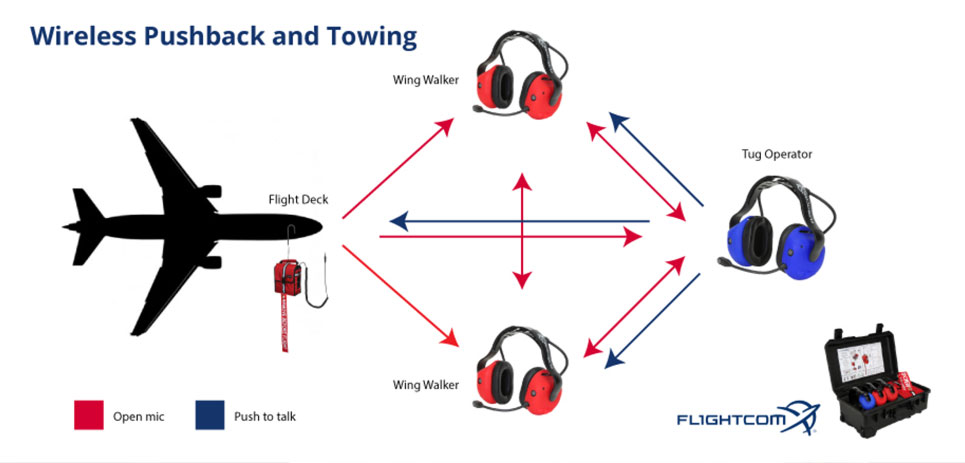Insight
Published and updated
10 Ways Wireless Headsets Help Ground Support Crews
Working ground support at an airport is rewarding, challenging and loud. You’re not trapped in an office, but you have to share your work environment with jet engines that can reach an ear-splitting 130 decibels at full throttle. That noise combined with the nature of the work—deicing, maintenance, wing walking and others that remove you from the sightline of fellow crew members—results in dangerous situations made even more hazardous by the potential for miscommunication.
To work safely and efficiently in such a challenging, high-noise environment, ground support crews need wireless headset systems that offer a unique combination of verbal communication, freedom of movement and hearing protection. Here are 10 ways that wireless headsets help ground support crews.

10 Ways Wireless Headsets Help Ground Support Crews
- Communicate in real time. No need to rely on hand signals or subject your pushback crew to delayed relays about what’s being discussed between the flight deck and the tractor operator. Full-duplex, always-on communication keeps every ground support crew member engaged. Everyone can talk and be heard at the same time if need be, but most important—warnings and directions can be declared and heard immediately.
- Free up hands for actual work. Whether you’re driving a tug or a deicing bucket truck, holding a hose or signaling a pilot during pushback, wireless headsets free up your hands to do your job safely and efficiently.
- Improve pushback and towing. Connect the pilot, tug operator and wing walkers to cut down on time spent on pushback and towing. Customize the configuration so that the flight deck only hears the tug operator, while the tug operator and wing walkers hear everything.
- Make deicing safer. Let sprayer operators and drivers give each other precise instructions and status reports without stopping work. Connect multiple crews, if necessary, and enable them to work in lockstep to reduce delays.
- Connect maintenance crews inside and outside of the aircraft. Clean and prepare planes for their next departure faster when you can check off maintenance requirements on the go.
- Protect hearing and communicate clearly in the one of the loudest environments on the planet. The busier the airport, the more unrelenting the noise. Long-term exposure to noise louder than 85 decibels can lead to permanent noise-induced hearing loss (NIHL). Many ground support personnel resort to foam ear plugs or earmuffs to protect their hearing, which further compromises verbal communication. Wireless headsets provide hearing protection while also enabling hands-free conversation. In fact, it’s less taxing to carry on a face-to-face conversation while wearing the headsets than to try to yell over the engine noise.
- Avoid accidents and injuries. The Flight Safety Foundation (FSF) estimates that for every 1,000 departures, one accident occurs and nine people are injured. Team communication for ground support crews is integral to avoiding accidents and injuries. Wireless headsets circumvent ambient jet noise while connecting ground support with the flight deck so that all communication is in real time. Only then can you execute precise maneuvers necessary to protect the people, aircraft, ramp and other equipment involved in pushback, deicing and maintenance.
- Reduce repair costs (to ramps and wires). The FSF also found that ramp accidents total approximately $10 billion in direct and indirect costs every year. That includes everything from aircraft and ramp repairs to paying for passenger food and lodging and disruptions to operations. Wireless headsets provide a cost advantage over wired headsets (in addition to freedom of movement and safety from electrocution in the event of a lighting strike of the aircraft) because the cost to replace cables and cords that get entangled in equipment quickly adds up.
- Improve situational awareness. Ground support crews need to have their heads on a swivel and hands on the job. Wireless headsets that enable communication as well as the ability to control how much noise you want to hear from your surrounding environment help identify potential hazards and eliminate distractions. This can be done with stereo listen-through technology, which protects your ears without muffling your senses to the point of isolation.
- DECT7® extends your range. Bluetooth is popular in wireless headsets, but it’s inadequate for a ground crew that needs to spread out further than 300 feet from a communication base station. It’s also subject to interference from other devices competing for the frequency. Wireless headsets with DECT7 wireless connectivity use an encrypted frequency that defies interference. Their range extends up to 1,600 feet line-of-sight away from the base station.
An Easy Financial Decision
Flightcom wireless headset systems are a fraction of the $250,000 average cost of a ramp accident. With more than 2 million pushbacks per year, Flightcom systems are the most widely deployed ground support communication headsets in the world. To learn more and see them in action, visit www.flightcom.net/commercial.